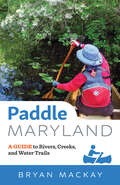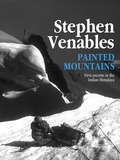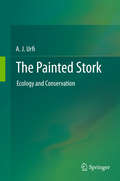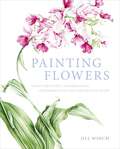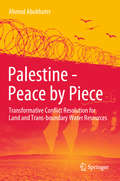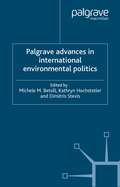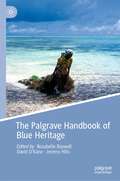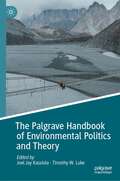- Table View
- List View
Paddle Maryland: A Guide to Rivers, Creeks, and Water Trails
by Bryan MacKayWith the Chesapeake Bay;¢;‚¬;€?the largest estuary in the United States;¢;‚¬;€?the Potomac, Monocacy, and Patapsco Rivers, and countless streams, creeks, swamps, and marshes, Maryland is an ideal locale for people to take to the water and enjoy the natural beauty of the Free State.In Paddle Maryland, lifelong Marylander and devoted paddler Bryan MacKay presents twenty-two of his favorite canoe and kayak trips. From lazy floats down the Potomac to swamp excursions on the Eastern Shore, each trip has been selected for its incredible scenery and ample opportunities to observe nature. Included are both tidal and nontidal paddling trips, and MacKay, an ecologist, describes the wildlife and vegetation you will encounter along the way. Considering biodiversity, conservation, and climate change, MacKay also discusses what these issues mean for Maryland;€™s waterways and their inhabitants.With its beautiful illustrations and wealth of practical advice and information, this indispensable guide will appeal to all who love to explore the natural wonders of Maryland with a paddle in their hands.Paddle Maryland is a companion guide to Hike Maryland and Cycle Maryland.
Paddle Maryland: A Guide to Rivers, Creeks, and Water Trails
by Bryan MacKayWith the Chesapeake Bay;¢;‚¬;€?the largest estuary in the United States;¢;‚¬;€?the Potomac, Monocacy, and Patapsco Rivers, and countless streams, creeks, swamps, and marshes, Maryland is an ideal locale for people to take to the water and enjoy the natural beauty of the Free State.In Paddle Maryland, lifelong Marylander and devoted paddler Bryan MacKay presents twenty-two of his favorite canoe and kayak trips. From lazy floats down the Potomac to swamp excursions on the Eastern Shore, each trip has been selected for its incredible scenery and ample opportunities to observe nature. Included are both tidal and nontidal paddling trips, and MacKay, an ecologist, describes the wildlife and vegetation you will encounter along the way. Considering biodiversity, conservation, and climate change, MacKay also discusses what these issues mean for Maryland;€™s waterways and their inhabitants.With its beautiful illustrations and wealth of practical advice and information, this indispensable guide will appeal to all who love to explore the natural wonders of Maryland with a paddle in their hands.Paddle Maryland is a companion guide to Hike Maryland and Cycle Maryland.
Paint 50 Landscapes: A complete guide to painting landscapes and seascapes in watercolour
by Joe Francis DowdenA unique artist's reference offering easy-to-follow, ingenious ideas and techniques for painting 50 popular landscapes in watercolour.Originally published as The Landscape Painter's Essential Handbook, this refreshed edition gives more space to the art and brings back into print one of the cornerstone books on landscape painting from an international watercolour master.The 50 landscapes included range from a gentle flower-filled meadow and hazy summer mountains, to a dramatic cliff scene and a rippling stream in sunshine. Each landscape is explored within a hardworking spread through exercises, step-by-step sequences and easy-to-follow instructions; master the principle and technique, and finish with the watercolour painting exercise.The comprehensive introductory section covering basic materials, techniques and colours makes this an indispensable reference for all artists. From snow-covered mountains to tranquil meadows, this unique artist's reference will show you how to paint 50 glorious landscapes in watercolour.Learn the basic techniques required to paint each landscape through the clear illustrations and step-by-step demonstrationsFollow the author's practical advice and ingenious ideas to achieve the best results, and refer to his fantastic finished paintings for further inspirationUse the indispensable introduction to discover the essential materials, basic techniques and key principles for capturing landscapes.The must-have practical reference that no landscape painter should be without!!
Painted Mountains: First ascents in the Indian Himalaya
by Stephen Venables‘The mountains are crystal under the blue sky, as we climb up our untouched peak. This is why we climb.’In this fast-paced, refreshingly honest account, Stephen Venables invites you on an adventure like no other. Delving deeply into the unknown, the unclimbed and the undiscovered, Painted Mountains details the stories of two very different expeditions: the first ascent of 6,000-metre Kishtwar-Shivling in the Indian Himalaya alongside Dick Renshaw, before embarking on an Indo-British Expedition led by Harish Kapadia to Rimo: the Painted Mountain.‘Most of us are content to settle for some sort of compromise between the desire to survive and the desire to retain an element of uncertainty.’Venables – the first Briton to climb Everest without oxygen – does not shy away from the obvious challenges that come hand-in-hand with tackling expeditions such as these; this account details the highs and the lows, the dropped equipment, the toll of extreme conditions and the shining successes of reaching a summit – all while retaining a sense of humour and an unwavering enthusiasm for the thrill of the climb. Venables’ get-up-and-go attitude makes this a delightful read; he is never one to shy away from an opportunity, be it arisen from a year-long dream or a spontaneous invite.Painted Mountains is an invaluable education for anyone who is interested in the greater mountain ranges explored in this book, as well as an inspirational tale of the commitment to a dream, the birth of new friendships and the innumerable rewards of time spent in the mountains.
The Painted Stork: Ecology and Conservation
by A. J. UrfiThe book will cover the entire range of the Painted Stork--beyond its stronghold in India and Sri Lanka to other countries--E Asia as well. For the sake of comparison, relevant information will be included about the other species of storks--both solitary as well as colonial, of Asia, as well as those in other parts of the world. Certainly plenty of references will be made about the work done on the American Wood Stork. Studies are underway in order to better understand the role of the monsoon rains on the nesting pattern of Painted Stork, besides attempting a review of the global status of the species. The former is likely to be of interest in augmenting our understanding about how global climate change is going to affect birds across India and the second is likely to raise interesting points about the distribution of species and their ranges. Both these studies will be carried through 2009 and should hopefully be included in the proposed book. Naturally, the focused interest in field research on the Painted Stork has resulted in accumulation of considerable information on this particular species, which is beyond the information contained on some standard Indian and international works and ornithological texts. The author hopes to include the entire spread of information of this species--from its systematics, evolution, distribution, ecology to its role in human culture as well as its association with mythologies. In other words, topics have not been restricted to the areas of the author’s research but have spilled over into areas of anthropology, ecology, conservation, etc.
Painting Flowers: Create Beautiful Watercolour Artworks With This Step-by-Step Guide
by Jill WinchWhat could be more satisfying than producing a beautiful painting of a flower? Jill Winch is an award-winning botanical artist and has been teaching people to paint and draw flowers for many years. In this delightful book, she teaches the key skills for making successful paintings of flowers in watercolor, the medium of choice for botanical artists. She breaks the process down into manageable steps, taking examples from a wide range of flowers. Throughout the book, Jill's own beautiful paintings provide inspiration and guidance.
Painting the White House Green: Rationalizing Environmental Policy Inside the Executive Office of the President
by Randall Randall LutterPresidents, like kings, lead cloistered lives. Protecting the president from too much isolation are advisers and aides who help ensure that the administration achieves its policy goals while enjoying broad political support. In economics and environmental policy, where disagreement among stakeholders and expert opinion is especially strong, the president needs good advice about political strategy, as well as unbiased information about the substance of policy issues. It is the latter need that the Council of Economic Advisers (CEA) is intended to address. Painting the White House Green collects personal essays by eight Senior Staff Economists for Environmental and Natural Resource Policy who worked within the CEA from 1992 to 2002. These authors confirm the council's 'severe' view of many environmental initiatives, a perspective that led President Clinton to label his economic advisers as 'lemon suckers.' At the same time, they demonstrate that the emphasis on efficiency was to offer more effective environmental protection at lower cost. Thinking 'green' meant thinking consistently about both economics and the environment. The essays in this innovative book present lively debates on clean air, climate change, and electricity deregulation that pitted economists at CEA, the Office of Management and Budget, and often the Treasury Department, against political advisers in the White House and officials at EPA and other agencies. The essays present vivid portraits of the power plays involved in environmental policymaking, rare insights into presidential decisionmaking, and revealing details of the ways that economic thinking influences-or is neglected-in a wide range of policy decisions.
Painting the White House Green: Rationalizing Environmental Policy Inside the Executive Office of the President
by Randall Lutter Jason F. ShogrenPresidents, like kings, lead cloistered lives. Protecting the president from too much isolation are advisers and aides who help ensure that the administration achieves its policy goals while enjoying broad political support. In economics and environmental policy, where disagreement among stakeholders and expert opinion is especially strong, the president needs good advice about political strategy, as well as unbiased information about the substance of policy issues. It is the latter need that the Council of Economic Advisers (CEA) is intended to address. Painting the White House Green collects personal essays by eight Senior Staff Economists for Environmental and Natural Resource Policy who worked within the CEA from 1992 to 2002. These authors confirm the council's 'severe' view of many environmental initiatives, a perspective that led President Clinton to label his economic advisers as 'lemon suckers.' At the same time, they demonstrate that the emphasis on efficiency was to offer more effective environmental protection at lower cost. Thinking 'green' meant thinking consistently about both economics and the environment. The essays in this innovative book present lively debates on clean air, climate change, and electricity deregulation that pitted economists at CEA, the Office of Management and Budget, and often the Treasury Department, against political advisers in the White House and officials at EPA and other agencies. The essays present vivid portraits of the power plays involved in environmental policymaking, rare insights into presidential decisionmaking, and revealing details of the ways that economic thinking influences-or is neglected-in a wide range of policy decisions.
Palaeobiology of Middle Paleozoic Marine Brachiopods: A Case Study of Extinct Organisms in Classical Paleontology (SpringerBriefs in Earth Sciences)
by Rituparna BoseFossil species appear to persist morphologically unchanged for long intervals of geologic time, punctuated by short bursts of rapid change as explained by the Ecological Evolutionary Units (EEUs). Here, morphological variation in Paleozoic atrypide morphology at the subfamily level (Atrypinae and Variatrypinae) from the Silurian and Devonian time intervals in the third Paleozoic EEU (~444-359 my) were investigated using relatively new techniques of quantitative modeling. The study explains how a group of closely related taxa in atrypide subfamilies exhibit morphological conservation through time in P3 EEU within the Eastern North America region.
Palaeoecology of Africa and the Surrounding Islands - Volume 26 (Palaeoecology Of Africa Ser.)
by Heine KlausThis volume offers comprehensive and up-to-date information on research in many different disciplines which give an overall insight into the environmental history of Africa.
Palaeoecology of Africa and the Surrounding Islands - Volume 26 (Palaeoecology Of Africa Ser.)
by L. Scott A. Cadman R. VerhoevenThis volume offers comprehensive and up-to-date information on research in many different disciplines which give an overall insight into the environmental history of Africa.
Paleoclimate, Global Change and the Future (Global Change - The IGBP Series)
by Raymond S. Bradley Thomas F. Pedersen Keith D. AlversonThis book provides a synthesis of the past decade of research into global changes that occurred in the earth system in the past. Focus is achieved by concentrating on those changes in the Earth's past environment that best inform our evaluation of current and future global changes and their consequences for human populations. The book stands as a ten year milestone in the operation of the Past Global Changes (PAGES) Project of the International Geosphere-Biosphere Programme (IGBP). It seeks to provide a quantitative understanding of the Earth’s environment in the geologically recent past and to define the envelope of natural environmental variability against which anthropogenic impacts on the Earth System may be assessed. A set of color overhead transparencies based on the figures in the book is available free on the PAGES website (www.pages-igbp.org) for use in teaching and lecturing.
Paleoclimatology: Reconstructing Climates Of The Quaternary (PDF)
by Raymond S. BradleyPaleoclimatology: Reconstructing Climates of the Quaternary, Third Edition—winner of a 2015 Textbook Excellence Award (Texty) from The Text and Academic Authors Association—provides a thorough overview of the methods of paleoclimatic reconstruction and of the historical changes in climate during the past three million years. This thoroughly updated and revised edition systematically examines each type of proxy and elucidates the major attributes and the limitations of each. Paleoclimatology, Third Edition provides necessary context for those interested in understanding climate changes at present and how current trends in climate compare with changes that have occurred in the past. The text is richly illustrated and includes an extensive bibliography for further research. Winner of a 2015 Texty Award from the Text and Academic Authors Association A comprehensive overview of the methods of paleoclimate reconstruction, and the record of past changes in climate during the last ~3 million years Addresses all the techniques used in paleoclimatic reconstruction from climate proxies With full-color throughout, and thoroughly revised chapters on dating methods, climate forcing, ice cores, marine sediments, pollen analysis, dendroclimatology, and historical records Includes new chapters on speleothems, loess, and lake sediments More than 1,000 new references and 190 new figures Essential reading for those interested in how present trends in climate compare with changes that have occurred in the past
Paleontology in Ecology and Conservation (Springer Earth System Sciences)
by Julien LouysThe fossil record contains unique long-term insights into how ecosystems form and function which cannot be determined simply by examining modern systems. It also provides a record of endangered species through time, which allow us to make conservation decisions based on thousands to millions of years of information. The aim of this book is to demonstrate how palaeontological data has been or could be incorporated into ecological or conservation scientific studies. This book will be written by palaeontologists for modern ecologists and conservation scientists. Manuscripts will fall into one (or a combination) of four broad categories: case studies, review articles, practical considerations and future directions. This book will serve as both a ‘how to guide’ and provide the current state of knowledge for this type of research. It will highlight the unique and critical insights that can be gained by the inclusion of palaeontological data into modern ecological or conservation studies.
Palestine - Peace by Piece: Transformative Conflict Resolution for Land and Trans-boundary Water Resources
by Ahmed AbukhaterThis book draws lessons and conclusions, based on the methodology outlined in the author's previous book, Water as a Catalyst for Peace (Routledge, 2013), and further charts the course to a more practical framework for achieving regional stability and justice. Past agreements are examined and analysed, outlining the change along the way that occurred to the land and people of Palestine. The book is written with the intention of exposing past events that led to the current situation, evaluating the current state of the conflict in light of new circumstances and the reality on the ground. Viable options are explored to seek a practical and satisfactory negotiated settlement that ensures justice and viability. In conclusion, a roadmap for future direction is proposed to achieve equitable water allocation through proper negotiation between Israel and Palestine and to ultimately settle the conflict. Water resources allocation is at the heart of this pragmatic framework and roadmap.
Palgrave Advances in International Environmental Politics (Palgrave Advances)
by M. Betsill K. Hochstetler D. StevisPalgrave Advances in International Environmental Politics provides a state of the art review of the major theoretical approaches and substantive debates of the field. The first section reviews the historical development of international environmental politics as well as the theoretical and methodological approaches used in its study. The following chapters each review the trajectory of a key research area within international environmental politics and elaborate on current approaches and debates. Case studies in each chapter illuminate the main theoretical questions that emerge from the review.
The Palgrave Environmental Reader
by Richard Newman Daniel PayneThe Palgrave Environmental Reader explores America's evolving fascination with nature and environmental concerns. From the New England Transcendentalists to the UN convention on climate change, this book includes works by Thomas Jefferson, Henry David Thoreau, Theodore Roosevelt, Rachel Carson, E.O. Wilson, and others. Consisting of thirty-five important pieces covering a variety of issues, this reader distinguishes itself from other writing on the subject by presenting more extensive excerpts and by emphasizing themes such as environmental activism, racism, and law.
The Palgrave Handbook of Africa’s Economic Sectors
by Evelyn F. Wamboye Bichaka FayissaThis handbook provides a reference resource to showcase insightful and nuanced perspectives on Africa’s agriculture, industry, services, and manufacturing sectors; factors affecting the sectors’ competitiveness; and the sectors’ contribution to employment, economic growth, and sustainable development. It also addresses the potential benefits that the sectors could harness from the planned Continental Free Trade Area (CFTA), and in particular how CFTA could increase the efficiency and competitiveness of these sectors.This book provides evidence-based holistic analyses of the past and current state of Africa’s economic sectors, with a strong emphasis on tangible and specific policy recommendations for the purpose of enhancing future economic growth, employment, and sustainable development of the continent. It also assesses the impact of the first-ever Continental Free Trade Area in Africa, and its potential implications for Africa’s integration into regional and global economy and competitiveness relative to other fast developing economies (such as those in Asia). This handbook gives an in-depth analysis of fundamental domestic factors that have relevance on the sectors’ expansion and growth and their contributions to employment, economic growth, and sustainable development in Africa with differential effects across the continent.
The Palgrave Handbook of Arctic Policy and Politics
by Ken S. Coates Carin HolroydThe Arctic has, for some forty years, been among the most innovative policy environments in the world. The region has developed impressive systems for intra-regional cooperation, responded to the challenges of the rapid environmental change, empowered and engaged with Indigenous peoples, and dealt with the multiple challenges of natural resource development. The Palgrave Handbook on Arctic Policy and Politics has drawn on scholars from many countries and academic disciplines to focus on the central theme of Arctic policy innovation. The portrait that emerges from these chapters is of a complex, fluid policy environment, shaped by internal, national and global dynamics and by a wide range of political, legal, economic, and social transitions. The Arctic is a complex place from a political perspective and is on the verge of becoming even more so. Effective, proactive and forward-looking policy innovation will be required if the Far North is to be able to address its challenges and capitalize on its opportunities.
The Palgrave Handbook of Blue Heritage
by Rosabelle Boswell David O’Kane Jeremy HillsThis handbook is unique in its consideration of social and cultural contributions to sustainable oceans management. It is also unique in its deconstruction of the hegemonic value attached to the oceans and in its analysis of discourses regarding what national governments in the Global South should prioritise in their oceans management strategy. Offering a historical perspective from the start, the handbook reflects on the confluence of (western) scientific discourse and colonialism, and the impact of this on indigenous conceptions of the oceans and on social identity. With regard to the latter, the authors are mindful of the nationalisation of island territories worldwide and the impact of this process on regional collaboration, cultural exchange and the valuation of the oceans. Focusing on global examples, the handbook offers a nuanced, region relevant, contemporary conceptualisation of blue heritage, discussing what will be required to achieve an inclusive oceans economy by 2063, the end goal date of the African Union’s Agenda 2063. The analysis will be useful to established academics in the field of ocean studies, policymakers and practitioners engaged in research on the ocean economy, as well as graduate scholars in the ocean sciences.
The Palgrave Handbook of Climate History
by Sam White Christian Pfister Franz MauelshagenThis handbook offers the first comprehensive, state-of-the-field guide to past weather and climate and their role in human societies. Bringing together dozens of international specialists from the sciences and humanities, this volume describes the methods, sources, and major findings of historical climate reconstruction and impact research. Its chapters take the reader through each key source of past climate and weather information and each technique of analysis; through each historical period and region of the world; through the major topics of climate and history and core case studies; and finally through the history of climate ideas and science. Using clear, non-technical language, The Palgrave Handbook of Climate History serves as a textbook for students, a reference guide for specialists and an introduction to climate history for scholars and interested readers.
The Palgrave Handbook of Environmental Labour Studies
by Nora Räthzel Dimitris Stevis David UzzellIn this comprehensive Handbook, scholars from across the globe explore the relationships between workers and nature in the context of the environmental crises. They provide an invaluable overview of a fast-growing research field that bridges the social and natural sciences. Chapters provide detailed perspectives of environmental labour studies, environmental struggles of workers, indigenous peoples, farmers and commoners in the Global South and North. The relations within and between organisations that hinder or promote environmental strategies are analysed, including the relations between workers and environmental organisations, NGOs, feminist and community movements.
The Palgrave Handbook of Environmental Politics and Theory (Environmental Politics and Theory)
by Joel Jay Kassiola Timothy W. LukeThis Handbook aims to provide a unique and convenient one-volume reference work, exhibiting the latest interdisciplinary explorations in this urgently burgeoning field of intellectual and practical importance. Due to its immense range and diversity, environmental politics and theory necessarily encompasses: empirical, normative, policy, political, organizational, and activist discussions unfolding across many disciplines. It is a challenge for its practitioners, let alone newcomers, to keep informed about the ongoing developments in this fast-changing area of study and to comprehend all of their implications. Through the planned volume’s extensive scope of contributions emphasizing environmental policy issues, normative prescriptions, and implementation strategies, the next generation of thinkers and activists will have very useful profiles of the theories, concepts, organizations, and movements central to environmental politics and theory. It is the editors’ aspiration that this volume will become a go-to resource on the myriad perspectives relevant to studying and improving the environment for advanced researchers as well as an introduction to new students seeking to understand the basic foundations and recommended resolutions to many of our environmental challenges. Environmental politics is more than theory alone, so the Handbook also considers theory-action connections by highlighting the past and current: thinkers, activists, social organizations, and movements that have worked to guide contemporary societies toward a more environmentally sustainable and just global order. Chapter “Eco-Anxiety and the Responses of Ecological Citizenship and Mindfulness” is available open access under a Creative Commons Attribution 4.0 International License via link.springer.com.
